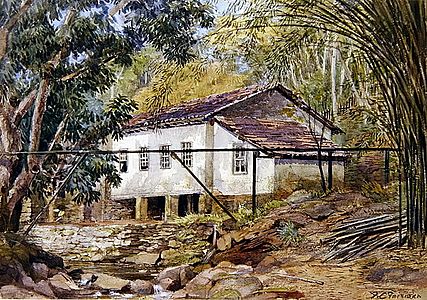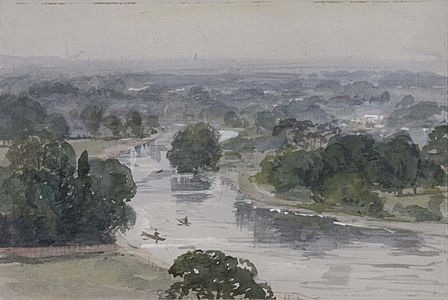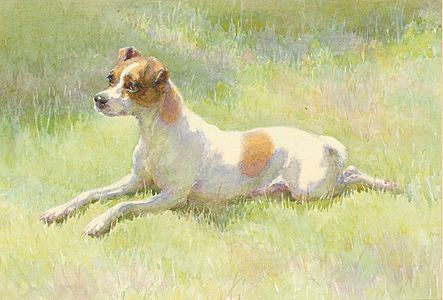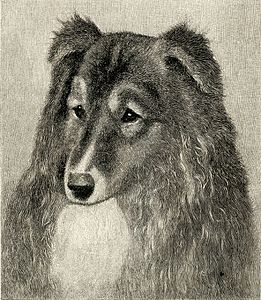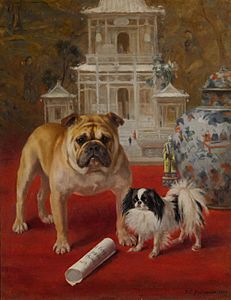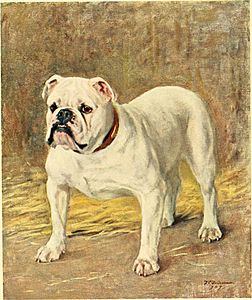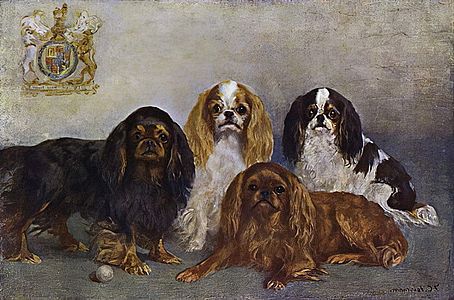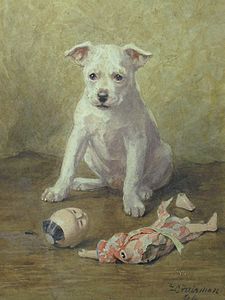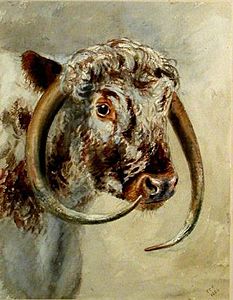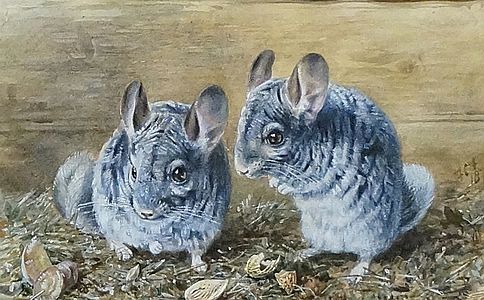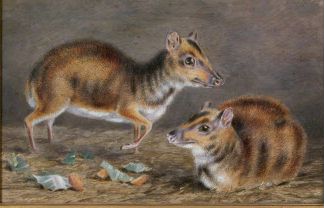Frances C. Fairman facts for kids
Quick facts for kids
Frances C. Fairman
|
|
|---|---|
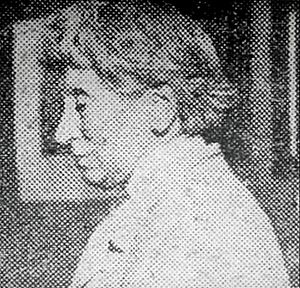
Fairman in 1910
|
|
| Born | 1839 Lynsted, England
|
| Died | February 1923 (aged 83–84) |
| Resting place | St Mary's Catholic Cemetery, Kensal Green |
| Known for | Animal paintings |
Frances Caroline Fairman (born in 1839, died in February 1923) was a talented British artist. She was known for her beautiful watercolour and oil paintings, and also for her illustrations. During her lifetime, she was most famous for painting pictures of dogs. Some of her dog portraits were even ordered by the Royal Family and important noble families! People called her "the Lady Landseer" because her animal paintings were so good, just like the famous artist Sir Edwin Landseer. She traveled to places like America, France, and Switzerland, bringing back lovely landscape sketches.
Fairman was born in Kent, England. She learned to paint in Paris from an artist named Louis Henri Deschamps. For most of her life, she lived and worked in London. She cared deeply about animals. Once, when she was older, she tried to stop a hansom cab driver from whipping his horse. She even got into trouble for it, showing how much she loved animals.
Contents
About Frances C. Fairman
Her Early Life
Frances Caroline Fairman, also known as "Fanny," was born in Lynsted, Kent, and was baptised on March 20, 1839. She spent most of her working life in London. When she was young, she lived with her parents and servants in Lynsted. By 1861, she was living in Paddington with her mother. In 1891, she lived in Streatham, London, and described herself as an artist who worked with watercolours. By 1911, she was living alone in Fulham, London, and was known as an artist who painted dog portraits from her home studio.
In 1887, Frances Fairman received money from her uncle, George Gosselin.
She passed away at the age of 85 in Chelsea, London. Her funeral was held on February 7, 1923. Queen Alexandra sent a special wreath with a message that said, "In deepest remembrance of a great animal artist. We shall all miss her greatly." This shows how much the Queen admired Fairman's work. Fairman had painted Edward VII's famous fox terrier named Caesar, who was known for following the king's funeral procession.
Her Art Career
Frances Fairman studied art in Paris with Louis Henri Deschamps. She became known as "the Lady Landseer" because of her amazing animal paintings. She used both watercolours and oils, and also worked as an illustrator. Her professional signature was often FCF or Frances Fairman. She was a member of the Society of Lady Artists. Her studio and home were at 4 The Avenue Studios, 76 Fulham Road, in South-West London. She was an active artist from about 1864 until 1917.
Before 1889, Fairman traveled to the Americas. She visited Florida and Brazil before 1897. She brought back and showed paintings that featured these places. She also made watercolour sketches during her travels in Switzerland. In 1917, one of her paintings, We owe it to King Edward, was shown at the Albert Hall. This was during a dog show held by the Ladies' Kennel Association. Fairman supported this association, and her painting was sold to help raise money for them.
-
British West Indies, painted before 1889
-
View near Amsteg with Uri-Rothstock in the distance, 1800s
-
View from Star and Garter, Richmond Hill, 1800s
Painting for Royalty
Frances Fairman painted nearly 30 pets for the Royal Family! This included King Edward VII's fox terrier, Caesar. She even had a studio at Buckingham Palace to do her work. The magazine Vote said that she had "painted many portraits of the favourite dogs of Queen Victoria, King Edward, and Queen Alexandra." They also noted that she had "attained a considerable reputation as an artist of animal life."
In 1897, the Duke and Duchess of York, Princess Victoria, and the Princess of Wales visited an exhibition of Fairman's dog portraits in London. It was called The Dog Show on Paper and Canvas. In 1910, the Queen asked Fairman to paint four more dogs.
In 1911, the Pall Mall Gazette newspaper praised Fairman. They said she was one of the few artists who could paint popular pets so well. They mentioned that she was the only living woman painter who had painted Queen Victoria's dogs by special request. She was also very good at painting Queen Alexandra's pet Japanese spaniels, Togo and Haru. These dogs were a special gift to the Queen from the Mikado. Fairman also painted a dog that belonged to the late Duke of Clarence, which later became King Edward's pet. She painted two of Princess Victoria's favorite dogs as birthday gifts from Queen Alexandra. Many important people in society wanted their dogs painted by Miss Fairman. She even had a kennel of lovely pugs in her studio, which helped her study dogs all the time.
In 1903, Fairman created a print of one of her paintings called The agreement: England and Japan, 1902. This painting showed a bulldog and a Japanese spaniel standing together with a Chinese pagoda behind them. The Queen even accepted a copy of this print.
Book Illustrations
Frances C. Fairman also created illustrations for books.
Exhibitions of Her Work
Fairman's paintings were shown in London starting from 1865. Here are some of the places where her art was displayed:
- Dudley Gallery Art Society, Egyptian Hall: She showed watercolours, including "promising or attractive sketches" (1886).
- Dudley Gallery Art Society: She exhibited Bob, the first prize old English Sheepdog, along with other animal portraits, and flower studies (1889).
- Society of Lady Artists: She showed various watercolours of fruit and flowers (1892).
- Dudley Gallery Art Society: Her watercolour A couple of owls and dead mouse was shown and praised for its "decided merit" (1890).
- Art exhibition at Victoria Hall, Bracknell: Her oil painting Three in a tub was displayed (1894).
- Society of British Artists: She showed Contemplating the fate of China and Three Japanese spaniels and a broken China doll (1896).
- Society of Lady Artists: She exhibited various dog portraits, including Miss Bowyer Smythe's Scotch dogs and Champion dachshund Pterodactyl (1896).
- Clifford's, Bond Street, London: A special exhibition called The Dog Show on Paper and Canvas was dedicated to her dog portraits (1897).
- Royal Academy Summer Exhibition: Her oil painting The platter clean: portraits of three Japanese dogs was shown (1897).
- Graves Galleries, Pall Mall, London: She showed various dog portraits, including United we stand (1898).
- Royal Academy Summer Exhibition: Her oil painting Three for the red was exhibited (1899).
- Society of Women Artists: She showed many of her "faithfully-depicted dogs" (1899).
- Grafton Galleries, Women's international Art Club: Four of her dog portraits, including Tina, were displayed (1901).
- No.10 Ryder Street, St James's, London: An exhibition focused on dogs featured her work. She was celebrated for her skill in painting well-known dogs (1901).
- Mendoza Galleries, St James's, London: Her watercolours were described as "excellent work" (1903).
- Society of Women Artists: Her watercolour Smooth Chow Yen How was noted for her "aptitude for animal painting" (1902).
- Dore Gallery, Bond Street, London: A collection of her works titled Dogs of all nations was shown (1904).
Where Her Art Is Kept
Frances C. Fairman's paintings are held in several important collections:
- Royal Collection Trust: They have six of her dog portraits, including Roy (1897), an oil painting. This picture is displayed at Osborne House.
- National Trust for Places of Historic Interest or Natural Beauty: They own her paintings A longhorn (1864), Gerbils (1872), and Chinchillas (1875).
- Richmond Borough Art Collection: They have her painting View from Star and Garter, Richmond Hill (undated).
Images for kids
-
The hansom cab, a type of horse-drawn carriage used as an early taxicab
See also
 In Spanish: Frances C. Fairman para niños
In Spanish: Frances C. Fairman para niños


